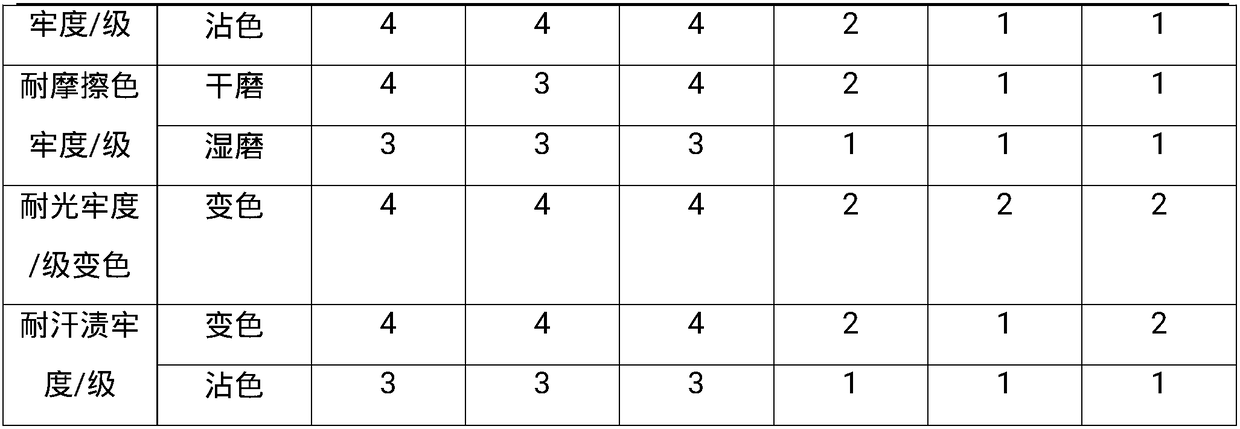Water-saving and emission-reducing dyeing and finishing technology for fabric
A fabric, dyeing and finishing technology, applied in the direction of fabric surface trimming, heating/cooling fabric, dyeing method, etc., can solve the problems of river and groundwater resource pollution, high cost of wastewater treatment, and achieve the benefits of sewage treatment, mild process conditions, and dyeing. uniform effect
- Summary
- Abstract
- Description
- Claims
- Application Information
AI Technical Summary
Problems solved by technology
Method used
Image
Examples
Embodiment 1
[0031] A water-saving and emission-reducing dyeing and finishing process for fabrics, comprising the steps of:
[0032] Step 1): Plasma treatment
[0033] The fabric to be dyed is drawn out from the roll and enters the plasma treatment device, and the plasma treatment device is started to etch and modify the fabric to be dyed;
[0034] Step 2): Desizing and Bleaching
[0035] Add desizing enzyme, chelating dispersant, wax remover and refining agent to the fabric for desizing treatment, add 15g of desizing enzyme, 3g of chelating dispersant, 5g of wax remover, and 6g of refining agent per liter of water; then add hydrogen peroxide , sodium silicate, scouring agent and chelating agent for bleaching treatment, adding 5g of hydrogen peroxide, 3g of sodium silicate, 10g of scouring agent and 3g of chelating agent for every liter of water;
[0036] Step 3): Cellulase treatment
[0037] Add cellulase to the bleached fabric for enzyme treatment, the amount of cellulase used is 2% o...
Embodiment 2
[0047] A water-saving and emission-reducing dyeing and finishing process for fabrics, comprising the steps of:
[0048] Step 1): Plasma treatment
[0049] The fabric to be dyed is drawn out from the roll and enters the plasma treatment device, and the plasma treatment device is started to etch and modify the fabric to be dyed;
[0050] Step 2): Desizing and Bleaching
[0051] Add desizing enzyme, chelating dispersant, wax remover and refining agent to the fabric for desizing treatment, add 15g of desizing enzyme, 3g of chelating dispersant, 5g of wax remover, and 6g of refining agent per liter of water; then add hydrogen peroxide , sodium silicate, scouring agent and chelating agent for bleaching treatment, adding 5g of hydrogen peroxide, 3g of sodium silicate, 10g of scouring agent and 3g of chelating agent for every liter of water;
[0052] Step 3): Cellulase treatment
[0053] Add cellulase to the fabric after bleaching for enzyme treatment, the amount of cellulase used ...
Embodiment 3
[0063] A water-saving and emission-reducing dyeing and finishing process for fabrics, comprising the steps of:
[0064] Step 1): Plasma treatment
[0065] The fabric to be dyed is drawn out from the roll and enters the plasma treatment device, and the plasma treatment device is started to etch and modify the fabric to be dyed;
[0066] Step 2): Desizing and Bleaching
[0067] Add desizing enzyme, chelating dispersant, wax remover and refining agent to the fabric for desizing treatment, add 15g of desizing enzyme, 3g of chelating dispersant, 5g of wax remover, and 6g of refining agent per liter of water; then add hydrogen peroxide , sodium silicate, scouring agent and chelating agent for bleaching treatment, adding 5g of hydrogen peroxide, 3g of sodium silicate, 10g of scouring agent and 3g of chelating agent for every liter of water;
[0068] Step 3): Cellulase treatment
[0069]Add cellulase to the bleached fabric for enzyme treatment, the amount of cellulase used is 2% of...
PUM
 Login to View More
Login to View More Abstract
Description
Claims
Application Information
 Login to View More
Login to View More - R&D
- Intellectual Property
- Life Sciences
- Materials
- Tech Scout
- Unparalleled Data Quality
- Higher Quality Content
- 60% Fewer Hallucinations
Browse by: Latest US Patents, China's latest patents, Technical Efficacy Thesaurus, Application Domain, Technology Topic, Popular Technical Reports.
© 2025 PatSnap. All rights reserved.Legal|Privacy policy|Modern Slavery Act Transparency Statement|Sitemap|About US| Contact US: help@patsnap.com


